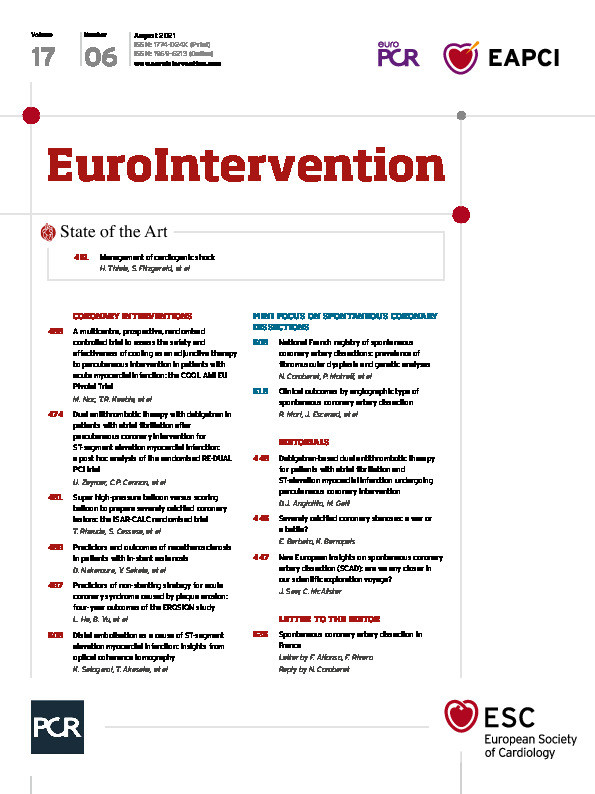For interventional cardiologists, management of heavily calcified stenosis represents a common challenge in daily practice, beginning with the diagnostic evaluation of the extension and severity of the calcium burden. On coronary angiography, operators systematically underestimate calcified lesions1. Careful independent core lab evaluation estimates this rate to be around 30-40%2. However, it is only with intravascular imaging that the diagnostic accuracy of calcium detection goes up to 80%3. The practical consequence of this limited diagnostic ability of coronary angiography is that heavily calcified lesions are often diagnosed too late, e.g., in case of a suboptimal balloon dilatation or, in the worst scenario, following an underexpanded coronary stent.
Different treatment options are available nowadays allowing a tailored approach to calcified lesions, ranging from more simple and cheap devices to more sophisticated and expensive tools4,5,6. These latter are usually avoided as treatment of first choice either intentionally or due to misdiagnosis of the calcium severity, while preference is often given to balloon-based therapies. The Comparison of Strategies to PrepAre SeveRely CALCified Coronary Lesions (ISAR-CALC) trial randomly investigated two different balloon-based strategies in patients with calcified lesions after unsuccessful plaque modification with standard non-compliant balloons – the super high-pressure non-compliant balloon with twin-layer technology (OPN; SIS Medical AG, Frauenfeld, Switzerland) versus the semi-compliant scoring balloon (NSE alpha™; B.Braun, Melsungen, Germany), followed by drug-eluting stent (DES) implantation7.
The primary endpoint of stent expansion index assessed with optical coherence tomography (OCT) was similar with both strategies. This trial has the merit of providing supporting evidence for a first-choice approach common to many interventional cardiologists. The authors should be commended for the quality of their clinical trial as shown by the angiographic and OCT core lab assessment, and by the independent adjudication of clinical events.
Nevertheless, interpretation of the findings should be cautious to prevent overenthusiastic adoption. Lesions suboptimally dilated with non-compliant balloons were included; although this might be considered a proxy of low vascular compliance it does not allow evaluation of the true severity of the calcium burden given the lack of pre-PCI OCT assessment. In fact, we have no information on the circumferential distribution or on the depth of calcium location, let alone the presence of calcified nodules that can be best treated with atherectomy devices and intravascular lithotripsy (IVL). In addition, these findings do not apply to uncrossable coronary stenoses that are best treated with rotational atherectomy4. Nevertheless, it is reassuring to observe two balloon-based strategies being equally effective with a relatively low complication rate.
The ISAR-CALC trial also investigated two different plaque modification concepts, i.e., a non-compliant balloon inflation at high pressure versus a semi-compliant balloon inflation with adjunctive scoring elements. With increasing inflation pressure the non-compliant balloon would provide only a limited diameter increase, at variance with the semi-compliant balloon that would significantly increase in diameter. Non-compliant balloons are often preferred in calcified lesions in order to dilate the most resistant part of the stenosis maximally, reducing the risk of vessel rupture at the points of lower resistance within the vessel – something that could occur more often with semi-compliant balloons due to their growing diameter (often resulting in “dog-boning”), especially at the level of more compliant coronary segments. These two basic concepts were further optimised in the devices investigated in the ISAR-CALC trial. With the high-pressure OPN balloon, the advantages of the non-compliant balloon are upscaled to reach a radial force of 35 to 40 atmospheres, with the goal of cracking the hardest part of the calcified lesion, while minimising the risk of vessel dissection or rupture at the adjacent compliant vascular segments. On the other hand, the presence of scoring edges on a semi-compliant balloon increases the radial force up to 15-20 times that of the conventional balloon. The scoring edges should also “cage” the semi-compliant balloon enabling a more controlled and uniform balloon expansion, therefore minimising a possible dog-boning effect and related risk of dissections. At the core lab angiographic evaluation, the high-pressure balloon treatment was associated with better lesion preparation, as suggested by an increased final minimal lumen diameter and reduced residual diameter stenosis, versus the scoring balloon treatment. No significant differences were reported in procedural risk in the selected patients, which should not be interpreted as a zero risk in more complex coronary anatomies. Further investigations are warranted to address whether the improved plaque modification achieved with the high-pressure balloon can also be expected to result in a facilitated stent implantation and expansion. For the time being, both devices can be used in calcified coronary stenosis “amenable for balloon dilatation” with a preference for scoring balloons in tortuous vessels and tight stenosis for their better crossing profile, while high-pressure balloons would be better suited to proximal lesions in larger vessels. With increasing experience in the management of heavily calcified stenoses and greater use of intravascular imaging, the threshold to adopt more sophisticated tools (e.g., atherectomy devices or IVL) should be lowered, especially in relation to circumferential calcification or calcified nodules. Stepping down from atherectomy or IVL to OPN or scoring balloons is always possible; the opposite might not be allowed at times by the occurrence of major vascular dissection or coronary perforation unable to be sealed because of a persisting unmodified plaque. Sometimes, it might be safer to prepare for a war, even if it turns out to be a small battle.
Conflict of interest statement
E. Barbato reports speaker's fees from BSCI and Shockwave. K. Bermpeis has no conflicts of interest to declare.
Supplementary data
To read the full content of this article, please download the PDF.

